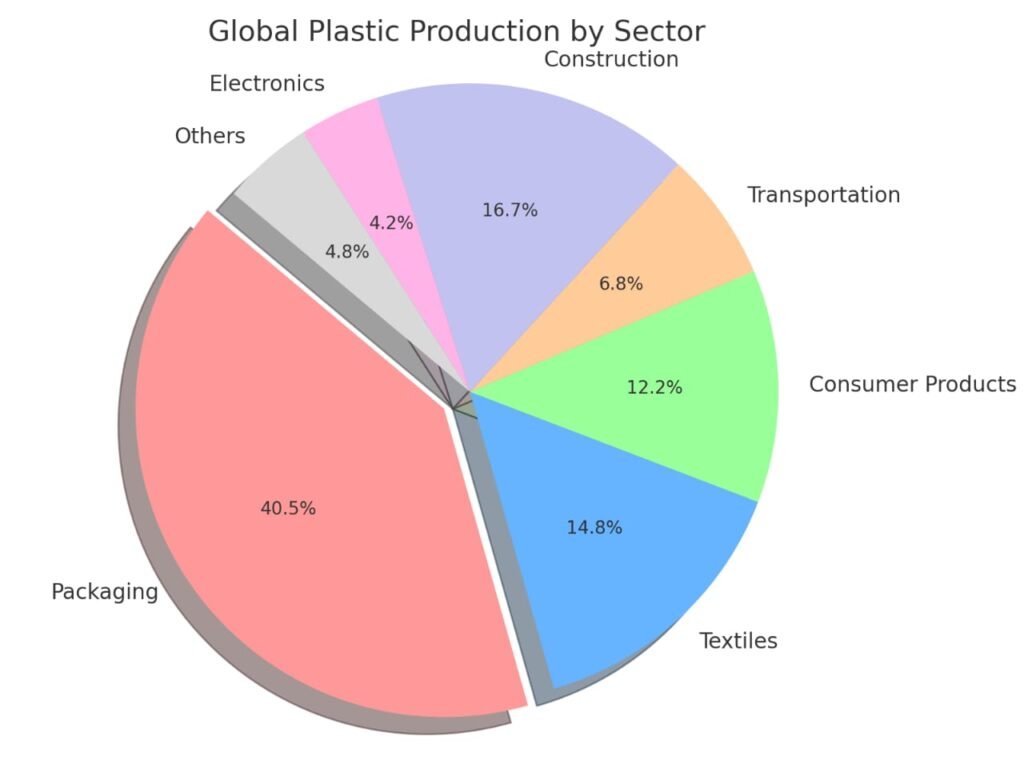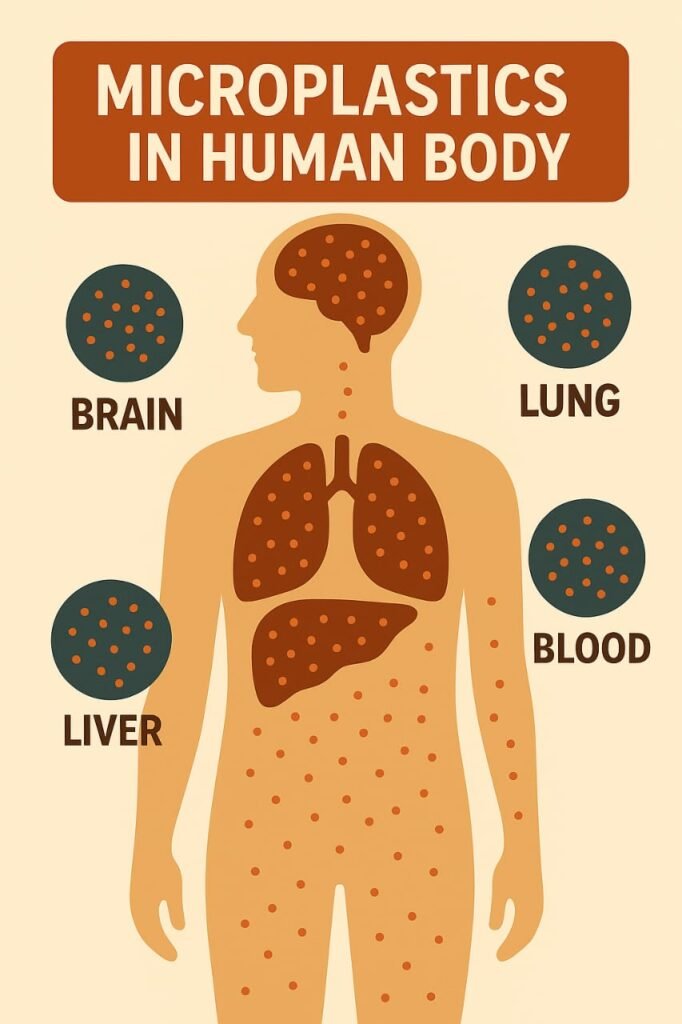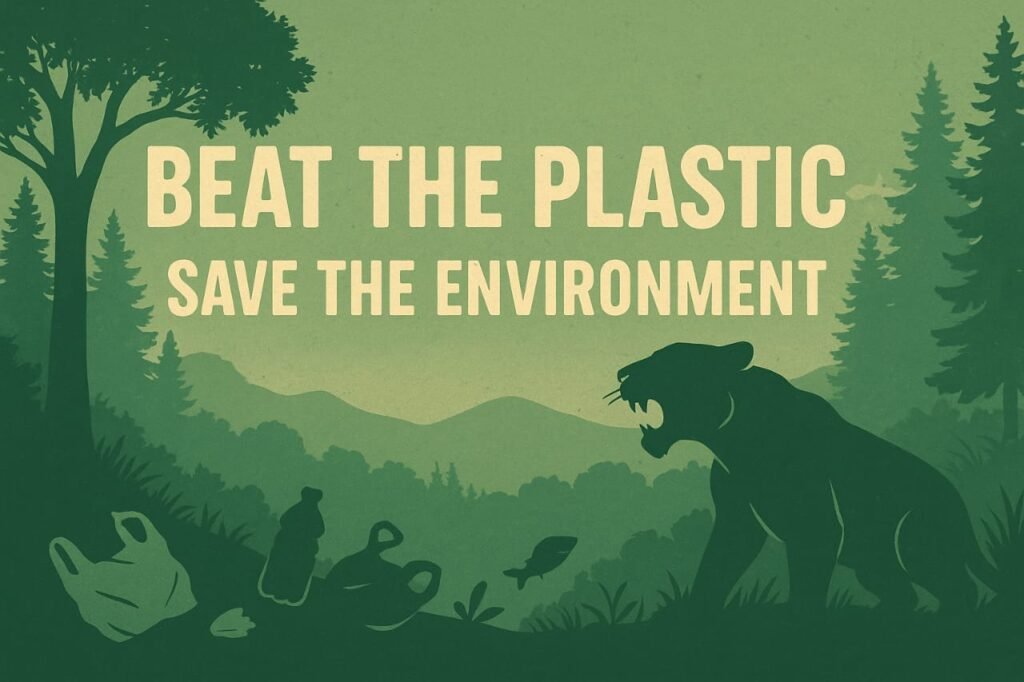Every year on June 5, we observe World Environment Day. This year too, we do the same. The theme for 2025 is clear and urgent: “Beat Plastic Pollution”.
Contents hide
World Environment Day 2025: When Plastic Began Consuming the Earth
When plastic was first created in 1862 and later became commercially viable as a fully synthetic material, it was hailed as a revolutionary scientific invention. Lightweight, cheap, and easy to mould into different forms, it began replacing metal, wood, fabric, and more. It soon became a part of everyday life.

However, the miracle turned into a menace. Plastic, once seen as a blessing, has now become a dangerous curse. Today, it is threatening every ecosystem—humans, animals, forests, oceans, rivers, the air, and even the climate.
Plastic: A Hidden Predator in the Forest
Think plastic is only a problem for humans? Think again.
Even wild animals in remote forests are falling victim to plastic pollution.
Plastic reaches deep into jungles through various channels—rivers that flow through forested areas carry waste with them, and roads cutting through wildlife zones often see plastic dumped by travelers.
Tourists on jungle safaris frequently leave behind wrappers, bags, and bottles.
Wild animals often mistake these items for food and ingest them, leading to illness, suffocation, and in many cases, death.
Grazing animals like cows are especially vulnerable, as they unknowingly consume plastic mixed with vegetation, causing serious health issues and even fatalities.
Other grazing animals like deer, goats, and horses are equally at risk wherever human activity and plastic waste intersect with natural habitats.
Plastic pollution has now become such a significant issue that even protected areas under Project Tiger face its devastating effects.
In the Depths of Rivers and Oceans: Plastic’s Deadly Web
Our oceans are becoming the world’s largest dumping grounds for plastic. Plastic reaches rivers via:
- Wind-blown landfills
- Drain water
- Industrial discharge
Eventually, plastic waste finds its way into rivers and oceans, where it becomes a serious threat to marine life.
Sea creatures like turtles, fish, and seabirds can get trapped in plastic bags or nets, leading to injuries, choking, or even death. Example: Turtles mistake plastic bags for jellyfish and eat them, leading to blocked intestines and death.
Over time, larger pieces of plastic break down into tiny particles called microplastics.
These microplastics float in the water and are consumed by tiny organisms like zooplankton. Small fish eat these organisms, and larger fish eat the smaller ones, passing the microplastics up the food chain.
Eventually, they reach our plates through the seafood we eat, affecting human health as well.
In many cases, large marine animals like whales and sharks accidentally swallow plastic waste such as polythene bags, plastic bottles, and packaging materials, mistaking them for food. This often leads to their death.
It has been observed that when their bodies wash up on shore, their stomachs are found to be filled with large amounts of plastic waste. For example, in 2019, a young whale was found dead in the Philippines with over 40 kg of plastic in its stomach.
According to a recent study, 99% of seafood samples are contaminated with microplastics.
Microplastics in the Clouds: A New Environmental Threat
Even more alarming is the discovery that microplastics are now present in rainwater. A study conducted by researchers at IIT Patna, published in Theoretical and Applied Climatology (Springer, 2023), found that microplastics can evaporate along with ocean water, rise into the atmosphere, and later return to the earth with rainfall.
These tiny plastic particles were detected even in remote areas like Ladakh and the Himalayan foothills, indicating how far and wide plastic pollution has spread.
This groundbreaking finding has opened a new frontier in environmental science, revealing that no part of our ecosystem is untouched by plastic pollution.
Suffocating Roots and Soil: How Plastic Chokes the Earth
Plastic doesn’t just litter the ground—it disrupts the soil’s natural fertility.
Soil is alive with microorganisms vital for fertility. Microplastics contaminate the soil, harming these microbes and reducing their productive capacity.
Plastics contain harmful chemicals such as phthalates, commonly used as plasticizers to make plastics flexible, and Bisphenol A (BPA), both of which can leach into soil and water.
These chemicals have toxic effects on plant cells, hindering their growth and disrupting natural regeneration processes. Over time, this leads to slower forest growth and deteriorating ecosystem health.
Human Health: The Body Under Siege
Burning plastic waste—common in many villages, towns, and even city outskirts—releases extremely harmful toxins, including dioxins.
These toxic compounds are linked to serious health problems such as respiratory diseases, hormone disruption, and even cancers, especially lung cancer. Unfortunately, this practice continues due to a lack of awareness and proper waste disposal systems.
Even more alarming is the growing presence of microplastics in the human body. Studies have confirmed that tiny plastic particles are now being found in almost every major organ, including the blood, liver, kidneys, lungs, and even the brain.

A study published in Nature Medicine found that microplastics accumulate at higher levels in the human brain than in the liver and kidneys, with significantly higher concentrations observed in samples from 2024 compared to those from 2016.
These particles enter our bodies through multiple channels: primarily polluted air, contaminated drinking water, and food.
One of the most common yet overlooked sources of microplastic ingestion is our daily food packaging. When we order food online, take home meals from restaurants, or pack hot food in plastic containers, the heat causes chemicals and microplastic particles to leach from the plastic into the food.
Without realizing it, we end up consuming these harmful substances, turning our meals into toxic doses that gradually impact our health.
This invisible invasion poses a major threat to public health.
Plastic and Climate Change: An Invisible Link
Plastic is made from petroleum products and releases greenhouse gases when burned, contributing to global warming. In this way, plastic has become an invisible yet powerful driver of climate change.
Plastic Production
To make plastic, fossil fuels are burned, releasing large amounts of carbon dioxide and other greenhouse gases into the atmosphere.
Plastic Disposal
Plastic waste lying in landfills takes years to break down, during which it emits gases like methane, a potent greenhouse gas.
If plastic enters oceans, it breaks down into microplastic particles, which also release greenhouse gases as they degrade under sunlight.
From production to disposal, plastic continuously emits greenhouse gases. A study by Lawrence Berkeley National Laboratory found that in 2019, the production of virgin plastic alone released approximately 2.24 billion metric tons of carbon dioxide equivalent (CO₂e) into the atmosphere, accounting for about 5.3% of global greenhouse gas emissions.
[Ref: https://cen.acs.org/environment/greenhouse-gases/Plastic-production-belches-over-5/102/web/2024/04?]
According to a report published in The Guardian, by 2050, emissions from plastic production are expected to triple, potentially consuming up to one-fifth of the world’s remaining carbon budget and significantly accelerating global warming.
[Ref: https://www.theguardian.com/us-news/2024/apr/18/plastic-production-emission-climate-crisis?]
Thus, plastic has emerged as a serious threat to the climate and must be addressed urgently.
Irresponsible Tourism: A Plastic Curse on Wilderness
Tourists and locals often picnic in forested areas, leaving behind plastic waste such as bottles, wrappers, and bags that persist in the environment for centuries.
This litter not only pollutes the soil and water but also poses significant threats to wildlife, birds, and plant life, degrading biodiversity and the natural beauty of these ecosystems.
According to a 2021 report by the United Nations Environment Programme (UNEP) and the World Travel & Tourism Council (WTTC), the travel and tourism sector significantly contributes to plastic pollution, particularly through single-use plastic products. The report emphasizes the need for coordinated actions and policies to drive the industry toward sustainable practices.
[Ref: https://www.unep.org/news-and-stories/story/how-can-tourism-fix-its-plastic-problem?]
Junglefizz Speaks: Liberate Our Forests from Plastic

At Junglefizz, we see plastic not just as waste but as an ecological curse.
To save our forests, rivers, oceans, and wildlife, we must eliminate plastic from its roots.
What Can We Do for the Environment? Small Steps, Big Impact
- Ban single-use plastics at home, office, and business.
- Avoid littering during forest treks or travel.
- Join clean-up drives with local authorities.
- Educate children about plastic disposal and the environment.
- Plant more trees.
Conclusion: Time to Reconnect with Nature
Plastic pollution has forced us to question the cost of modern development. The silent forests, dying rivers, and endangered species are calling us back. It’s time to return to nature, without plastic.
Let World Environment Day 2025 be our turning point. Let us beat plastic pollution not just for us, but for every tree, bird, river, and animal that still calls Earth home.


